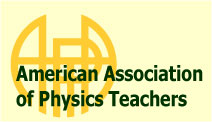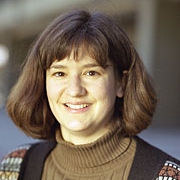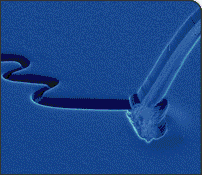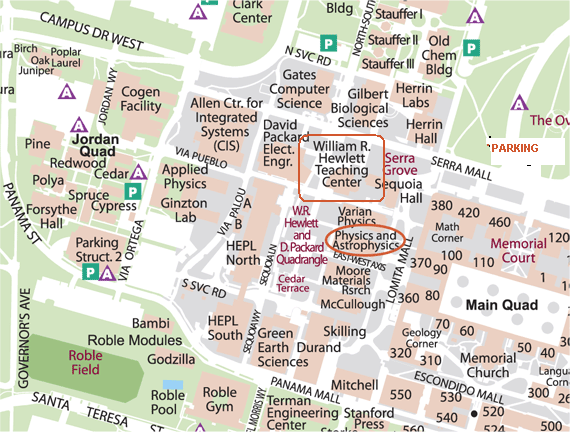 |
The Spring 2007 MeetingNorthern California/Nevada Section AAPT |
![[stanford]](../images/StanfordScene001.jpg)
Stanford/SLAC Local
Host: Rick
Pam |
|
Friday Night SocialStanford Linear Accelerator Center (SLAC) |
||
|
|
Directions to SLAC: Take I-280 to Sand Hill Road East (towards the bay). The entrance to SLAC is on the right a few signal lights down the road. Stop at the security gate to show your Photo ID. Tell the guard you're here for the AAPT talk at Kavli Auditorium. Kavli Auditorium is in the Kavli building to the left of the walkway that starts almost opposite the main driveway. For maps see http://www2.slac.stanford.edu/maps/slacarea.html. Try to get there a few minutes early to enjoy the beautiful surroundings, views of the bay, and the Visitor's Center, which among other things has a section of the accelerator tube, the experimental notebook showing the discovery of the psi-particle (containing charm quarks), Nobel Prize certificates , a background radiation detector system, and pre-historic mammal whose bones were discovered when excavating for the klystron gallery. 4:00 PM Visitors Center – Helen Quinn, informational tour 5:00 – 5:30 Kavli Auditorium – John Arthur will give a short talk entitled
"Amazing things we can do with X-rays—and some we hope to do." 5:30 – 6:30 Tom Abel will show us in 10 minutes how the universe began with
“A Simulated Tour of the Early Universe” 6:30 – 7:30 Reception hosted by the fine folks at SLAC at the picnic area just outside cafeteria. Come toast physics with us! |
|
Saturday ProgramHewlett Teaching Center, Stanford University |
||
|
|
8:00 Registration, Coffee, Donuts, and other culinary delights.8:45 Welcome and Announcements9:00 Show & TellShare your favorite demonstration or teaching tip. Since new teachers and section members will be at this meeting, you are encouraged to dust off some of your oldies but goodies. Pasco will present of their latest products. If you have handouts, please bring 100 copies. Time limit is 5 minutes per person. Presenting papers at Show & Tells is specifically discouraged. Invited Speakers10:00 “Quantum Mechanics of Nanostructures” Kathryn Moler, Center for Probing the Nanoscale (CPN), kmoler@stanford.edu
Kathryn Moler, Center for Probing the Nanoscale (CPN), kmoler@stanford.edu
The director for CPN will explain how quantum mechanics is used to understand the behavior of nanostructures at the edge of the macroscopic world. 11:00 “Bringing Nanoscience into the Classroom with Large Scale Nanoprobe Models”Kyle Cole, CPN Outreach, kylecole@stanford.edu
Although nanotechnology is a common media buzzword, very few classroom activities focus on nanoscale science. The Center for Probing the Nanoscale has developed hands-on activities that use large-scale nanoprobe models, such as the atomic force microscope, to give students an intuitive sense of nanoscale imaging while addressing the science content standards on forces and motion. 11:30 “35 Years of Physics Teaching in 30 minutes”Clarence Bakken, Palo Alto High and Gunn High Schools (retired), cbakken2001@yahoo.comA quick trip down memory lane from PSSC to retirement. Clarence Bakken will present a few anecdotes to illustrate his perspective on teaching and how he either kept or lost his sanity along the way. Or as he puts it, he retired in order to stop pun-ishing students. And what he's been up to since retiring. 12:00 LUNCHFor your convenience, and to help you save time and also to give you a chance to converse with interesting luminaries like yourself, we are providing lunch. Lunch is included as part of your registration fee. We also encourage you to take one of many tours of the Nanoscale Center. Raffle/Business Meeting:Report from the Officers and other business. Future meetings and dates will be discussed. Paul Robinson will report on the National AAPT business. A motion to raise dues to $20 will be proposed. Contributed Papers2:00 “Ramsauer-Townsend Effect”Phil Gash, CSU Chico Physics Department, pgash@operamail.comThe solution of the time-dependent Schrodinger's equation for a wave packet scattering by a square well is presented in real-time. When the well width is 1/2 the packet width and the incident energy is 2%-3% of the well depth, resonant scattering is exhibited by the presence of several narrow and closely spaced transmission peaks. The physics of these peaks is discussed and applied to explain the Ramsauer-Townsend Effect. 2:20 “Strings or Branes in Hyperspace? No Problem: Model Them with a Minkowski Diagram Analog”Douglas Leadenham, DeVry University, dleadenh@fre.devry.eduWe will see how to use Minkowski’s method of suppressing two of space-time’s 4 dimensions onto a single number line to model the electron, a multidimensional object, using only a strip of green bar paper. Your take-home models will have the property spin-1/2 besides giving you an idea of 8 of the universe’s many dimensions. Concluding the presentation is a proposed solution to the infamous vacuum energy-cosmological constant problem 2:40 “Least Action in Action - Lagrangians and Hamiltonians for Community College Students”David Marasco, Foothill College, dalmarasco@yahoo.comAn honors seminar covering Lagrangian and Hamiltonian Mechanics was taught at Foothill College in Winter 2007. This talk will cover a short history of the development of the class, the topics that were covered, areas for development, the future of the class and the issues involved in introducing these concepts to non-physics majors. 3:00 “An Optics Lab: Theory, Simulation, Experimentation, and Comparison”Duygu Demirlioglu, Holy Names College, duygud@aol.comThe ray approach to light propagation permits a natural integration of concept, simulation and hands-on exploration. We present an experiment that unifies numerical analysis and physical lab workan experiment that is transparent in concept, fast, simple, and yields excellent results. A light box or laser and a sheet of polar graph paper allow students to obtain data in a few minutes and verify theory and simulation that lead to correct experimental results. 3:20 “A New Look at the Bouncing Ball”Tim Erickson, Epistemological Engineering, tim@eeps.comWe will use a microphone to record a bouncing ping-pong ball. Then we'll use the sound to figure out the coefficient of restitution, see whether that coefficient really is constant, and put all of it together for pre-calculus students so they can see a practical application for summing infinite geometric series 3:40 “Spice Up Your Lessons With Video Clips From The Web”Dean Baird, Rio Americano High School, dean@phyz.orgThere are physics-teaching gems at YouTube, Google Video, and elsewhere on the web. Our students are the product of The Video Generation, so they find video clips very engaging. I’ve gathered a few and will share them here. I will also share some lessons written especially for use in conjunction with these clips. Most importantly I will show you where to find these clips so you can use them in the classroom. 4:00 “Physics Laboratory Course for Non-science Majors: The Physics of Dance”David J. Popalisky, Santa Clara University, dpopalisky@scu.eduI will discuss a co-taught laboratory-science course for non-science majors at Santa Clara University, "The Physics of Dance." This course integrates the experience of students performing basic dance movements with measurements of displacement, angle, force and other variables with respect to time. Through this dual experiment/experience approach where the student becomes the "object," the class explores fundamental physics and its limitations while developing an appreciation for the art of dance and its illusions. A student project involving impulse in vertical jumps will be used to illustrate learning outcomes. 4:20 “Global Warming, Cosmic Rays or Carbon Dioxide?”Charles Jordan, Foothill College, egonjoe@comcast.netCosmic ray flux is modulated by solar wind activity. Cosmic rays impacting aerosols cause them to seed clouds. Increased cloudiness decreases the sun's electromagnetic load on the earth and temperatures decrease and vice versa. Extra carbon dioxide is released from the ocean due to the warming, the result, not the cause, of Global Warming. Due to the cosmic ray mechanism, flying through the spiral arms of our galaxy has caused all the major ice ages. |
|
|
Hotels Nearby |
From Highway 101
From Interstate 280
Here is a parking link. (pdf) Note: most Stanford parking is free on Saturday. Check signs. Map of the area (280 is down, 101 and the Bay are up. The "oval" is upper right in the map; Hoover tower is off the map to the right):
|
Here are hotels that
are within a few minutes of Stanford University.
Comfort Inn Redwood City America's Best Inn Days Inn Palo Alto-Stanford Travelodge - Palo Alto Comfort Inn Palo Alto Stanford University Mermaid Inn |
Registration Fee |
Upcoming Events |
PTSOS News |
|
What a deal!
Your fee is waived for first-time attendees and students! The rest of us pay only $25, which includes lunch. Additional lunches will be available for spouses (spice?), friends, groupies, hangers-on, students, first time attendees, and gluttons for $10. A bargain at twice the price! |
Summer National AAPT Meeting Fall Meeting NCNAAPT Winter National AAPT Meeting Spring Meeting NCNAAPT Summer National AAPT Meeting Fall Meeting NCNAAPT |
Attention New Physics Teachers! PTSOS is here for you!PTSOS is an NCNAAPT-sponsored project, funded by by a donation from the Karl Brown Foundation, that helps physics teachers in their vulnerable first years of teaching. PTSOS is headed by Paul Robinson, Dean Baird, and Stephanie Finander. The last of three day-long workshops was March 25th at San Mateo High. Other veteran teachers are being signed up to help out small groups of local teachers through mentorships and also to help run workshops. |
Updated April 24, 2007
